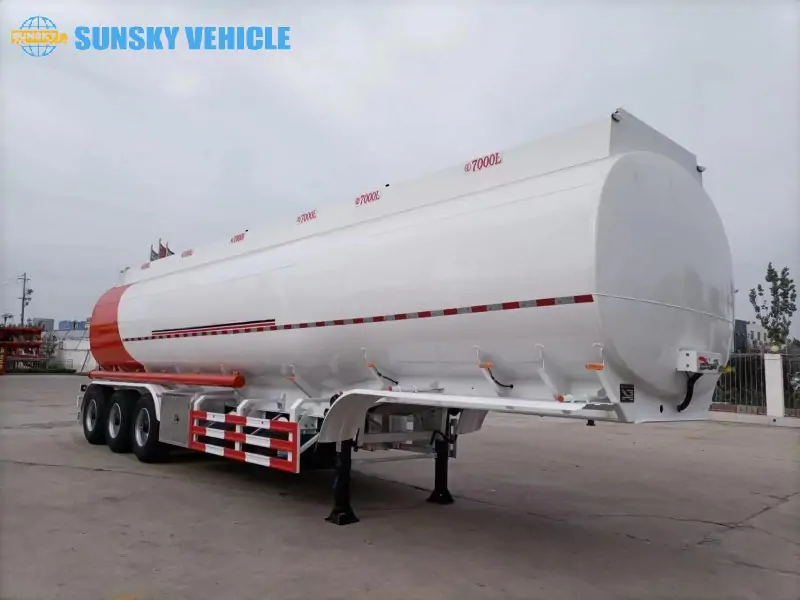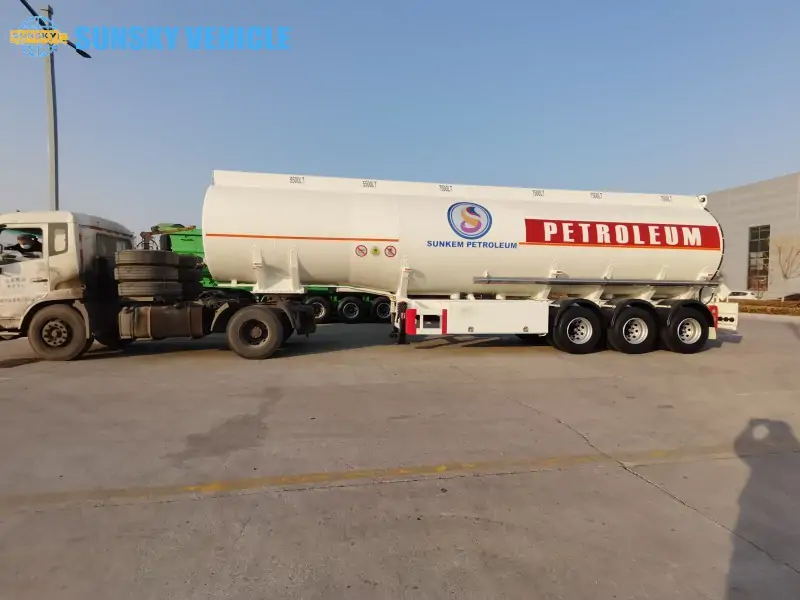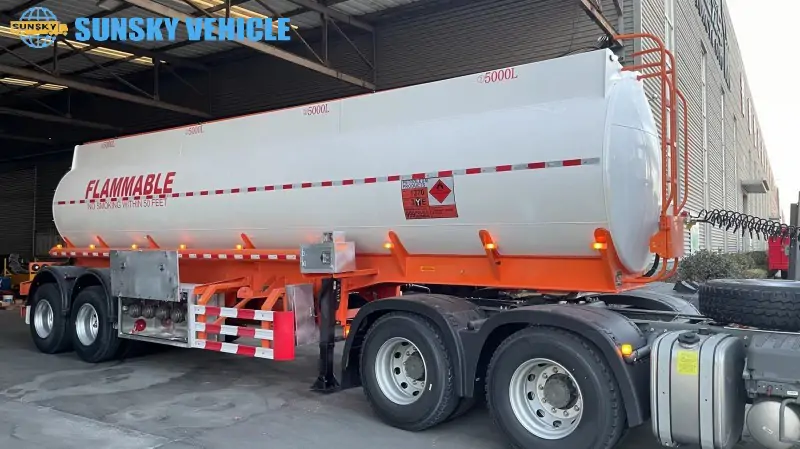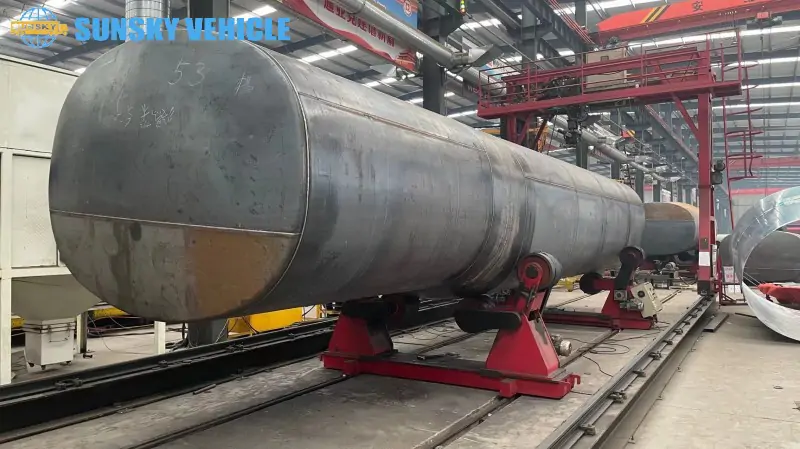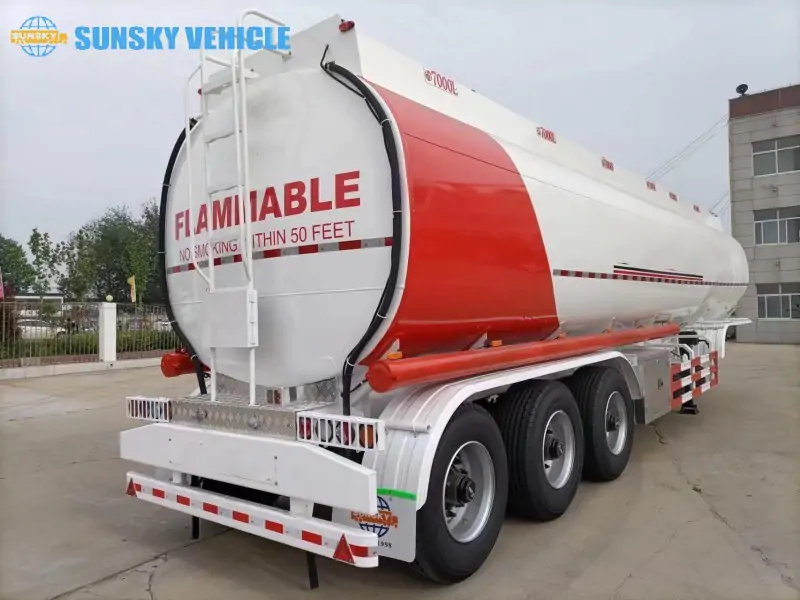
Core Capacity Data: Tank Truck Types and Configurations
To understand tank truck capacities accurately, it is important to classify them by type and configuration. Below is a reference table for common tank truck types worldwide, their typical capacity ranges, applications, and regulatory regions.
| Tank Truck Type | Typical Capacity (Liters) | Typical Applications | Regulatory / Region |
|---|---|---|---|
| Light Distribution Truck (Rigid Truck) | 5,000 – 18,000 L | Urban distribution, small fuel stations, airport supply | EU, Asian city areas |
| Standard Fuel Tanker Trailer | 25,000 – 40,000 L | Refinery-to-gas-station long-haul transport | Global |
| High-Capacity North American Configuration (A/B/C Trains) | 45,000 – 65,000 L+ | Regions with relaxed axle weight limits (NA, Australia) | US DOT, Australia |
| Rail Tank Car | 80,000–150,000 L | Cross-border or bulk crude/fuel transport | Railway transport standards |
Note: Values are typical ranges; actual capacity depends on tank design, compartments, materials, tare weight, and local regulations.
Capacity Limiting Factors: Why Tank Trucks Can’t Always Fill 100%
Many people assume that a tank truck’s capacity is solely determined by the geometric volume of the tank. In reality, the key limiting factor is the weight.
Weight Regulations by Country/Region
Worldwide, road safety, bridge protection, and infrastructure maintenance require strict limits on the maximum gross vehicle weight (GVW). Once the maximum payload is determined (GVW minus vehicle tare weight), the actual liters a tank truck can carry is effectively set.
Bridge Formula (North America): In the U.S., the bridge formula restricts the weight of axle groups based on their spacing to protect bridges. This indirectly limits how much fuel can be loaded, rather than relying solely on tank volume.
EU and China GVW Limits: In the EU and China, articulated trucks have clear maximum GVW limits (e.g., approx. 40 tons). This fixes the maximum fuel weight, which directly determines the liters that can be carried.
Example: Why a 45,000 L Tank Might Only Hold 42,000 L of Diesel
Assume a semi-trailer tank truck with a maximum payload of 35,000 kg (35 tons).
- For gasoline (~0.75 kg/L):
Capacity = 35,000 kg / 0.75 kg/L ≈ 46,667 L - For diesel (~0.85 kg/L):
Capacity = 35,000 kg / 0.85 kg/L ≈ 41,176 L
Even though the tank volume might exceed 45,000 L, diesel’s higher density reduces the actual fillable liters under weight limits.
Fuel Density and Its Impact on Capacity
| Fuel Type | Approximate Density (kg/L) | Notes |
|---|---|---|
| Gasoline | 0.73 – 0.77 | Lower density, allows more liters within weight limit |
| Diesel | 0.82 – 0.87 | Higher density and actual fillable liters decrease |
| Heavy Oil / Asphalt | >0.9 | Highest density, requires special handling, fewer liters |
Safety Ullage Space
In addition to weight and density, tank trucks must never be filled 100%. Regulations require a safety ullage space of 3%–5% of total tank volume. This prevents fuel expansion due to temperature changes and controls liquid surge during braking or acceleration.
Tank Design and Its Effect on Effective Capacity
Achieving a safe and efficient tank truck capacity depends heavily on precise tank design and material selection.
Compartment Design (Compartments) and Capacity Allocation
Modern tank trucks rarely use a single large tank. Instead, multiple compartments are used to improve safety and functionality.
- Transporting different fuel grades simultaneously (e.g., 92-octane gasoline, diesel, kerosene)
- Enhancing safety by isolating liquids to prevent spills or accidents
- Reducing liquid surge during turns and emergency braking
Example: A 40,000 L semi-trailer tank might be divided into 5 compartments with capacities of 8,000 L, 8,000 L, 7,000 L, 9,000 L, and 8,000 L, respectively.
Tank Structure and Internal Stability Systems
Baffles/Surge Plates: Installed inside compartments, these structures redirect liquid flow to reduce momentum and improve vehicle stability during turns or sudden braking.
Tank Shape: Oval and cylindrical tanks are common for better structural strength, lower center of gravity, and optimized capacity utilization.
Material Selection and Capacity Optimization
| Material | Advantages / Notes |
|---|---|
| Aluminum Alloy | High strength-to-weight ratio, lighter tare weight, allows more liters under GVW limits; mainstream choice for modern road tank trucks. |
| Carbon Steel / Stainless Steel | Heavier tare weight, lower cost, higher strength; used for corrosive chemicals, asphalt, LNG. |
Tank Truck Operations, Measurement, and Loading Systems
A tank truck is not just a container; it is a precise measurement and distribution system. Accurate capacity measurement is crucial for trade settlement and safety.
Measurement Accuracy and Certification
- Calibration: Tank trucks must be regularly calibrated by government-authorized or professional agencies to ensure trade fairness. A calibration certificate is mandatory for legal operations.
- Units: Fuel volumes are often temperature-corrected (ATC – Automatic Temperature Compensation) to standardize trade volumes.
Loading and Unloading Interfaces
- Top vs. Bottom Loading: Top loading is traditional but slower and riskier. Bottom loading is modern, faster, and safer.
- Vapor Recovery Systems (VRS): Required to capture evaporated fuel during loading/unloading, meeting environmental regulations.
How to Calculate Tank Truck Capacity
Accurate calculation of maximum fuel load under specific regulations is essential for logistics planning. Use the simplified formula:
Actual Fuel Volume (L) ≈ (GVW Limit (kg) - Vehicle Tare Weight (kg) - Other Loads (kg)) / Fuel Density (kg/L)
- Subtract safety ullage (3–5% of tank volume)
- Include vehicle tare weight: chassis, tank, driver, permanent equipment
- Use correct fuel density, considering temperature
Start your project today and get a high-performance semi-trailer solution tailored specifically to your unique needs.Robust and Durable, Achieve Exceptional Transport
Legal and Regional Differences
Tank truck capacities are strictly governed by national and regional laws. Understanding these rules is critical to avoid fines, accidents, or infrastructure damage.
United States Federal/State Weight Regulations
- Maximum gross vehicle weight (GVW) limits
- Axle weight restrictions
- Bridge formula enforcement
Europe, UK, Australia, China
- EU: maximum GVW for articulated trucks approx. 40 tons
- UK / Australia: similar weight limits, often specified per axle
- China: clear GVW limits for road safety
Overload Risks and Penalties
Overloading can lead to fines, vehicle damage, accelerated wear, or even accidents. Always verify local regulations before loading.
Checking Local Regulations/Permits
Transport companies should consult government transportation agencies or official websites to confirm maximum GVW, axle limits, and any special permits required for heavy loads.
Loading Optimization and Safety Tips
- Evenly distribute cargo to avoid lateral imbalance
- Control maximum fill height; do not exceed tank height
- Monitor tire pressure and maintain tires regularly
- Regularly inspect suspension, beams, articulations, and supports
- Use onboard weighing systems/load monitoring equipment
- Common accidents include overturns, axle failure, tire blowouts—take preventive measures
Summary and Recommendations
In this guide, we reviewed typical tank truck capacity ranges, calculation methods, and key factors affecting loading. Understanding regulations and fuel density is critical for safe and efficient operations.
- Vehicle type and compartment configuration
- Local and international weight regulations
- Fuel density and ullage requirements
- Onboard measurement and load monitoring systems
We encourage operators to perform their own capacity calculations and consult with professional manufacturers or local authorities for precise parameters.

